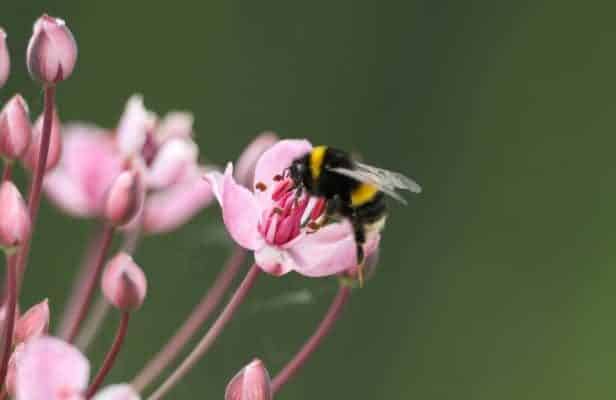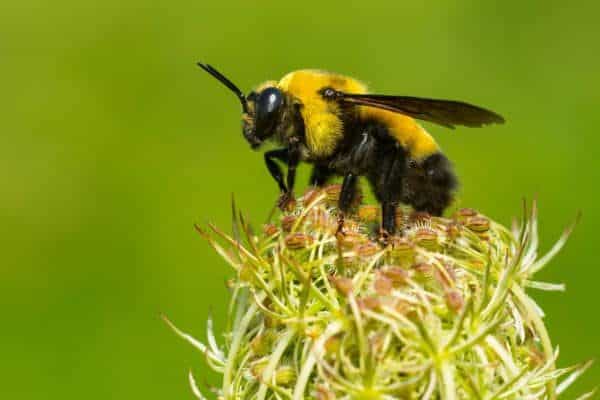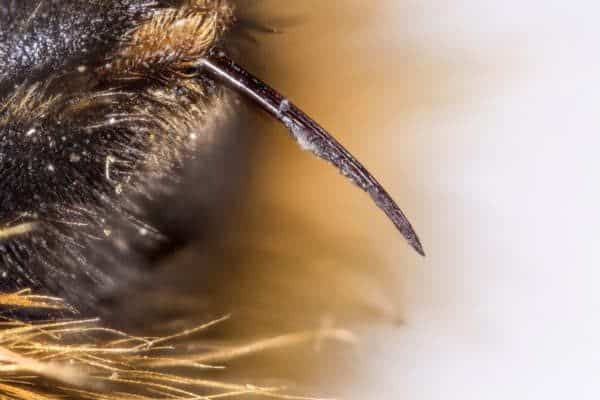Their distinctive bands of black and yellow instantly set them apart from honeybees. There’s also the fact that they’re stockier, heavier, and capable of stinging more than once and getting away with it, too.

But just how aggressive are bumblebees?
Bumblebees are not aggressive, they are much more tolerant with human interaction than wasps, yellowjackets, and honey bees. Females have a stinger, and the ability to sting multiple times. Male bumblebees are stingless. Bumblebee stingers do contain venom and when stung by them it can be painful and can cause an allergic reaction in some people.
That in a nutshell is the outcome of our investigation on these robust little fuzzies. That said, we also did a little more digging on these fascinating brightly colored bugs and have dutifully presented the most interesting points below.
Bumblebees’ main distinguishing features
Bumblebees are just one species of the vast bee family which consists of 20,000 species — North America is actually home to 40 species of bumblebees.
Like every other member of that extensive, amazingly productive family, bumblebees have five eyes, stiff hair strands on their hind legs (otherwise known as their pollen baskets), and a honey stomach for gathering nectar.
That said, bumblebees are pretty unique and come with the following features which set them apart:
Appearance
One of the main distinguishing features of bumblebees is their stocky body which gives them a rather tubby appearance.
While they mostly are very distinctive yellow and black, they can also be orange and black or red and black. In addition to their vivid bands, they also feature soft hairs which makes them appear fuzzy.
There’s also the fact that they simply outdo honeybees in the size stakes making them capable of carrying more pollen and nectar away with them.
Social structure
While honeybees love nothing more than creating large hives with family members running into tens of thousands, bumblebees prefer domestic arrangements of more modest size.
Hence their hives tend to be significantly smaller in comparison and members do not generally exceed two hundred in number.
For more information on how the social structure of bumblebees works and how their colonies work it is worth reading this article we have written, Do Bumblebees Live Alone or in Colonies?
Proboscis-length
Unlike honeybees which have rather short proboscises, varying species of bumblebees possess proboscises of varying lengths — a feature that makes them ideal for pollinating different varieties of flowers since they are able to extract nectar from an extensive range of them.
They are also a rather determined bunch who generally do not permit a little thing like proboscis-length to get in the way of what they want. The proof can be found in those furry little fuzzies whose proboscises don’t quite make the cut, simply nibbling at the base of a flower to get at its precious nectar.
Honey production
Their larger size and carrying capacity notwithstanding, bumblebees produce less honey than their smaller sized counterparts.
This is due to the fact that they produce just enough for their own needs rather than copious amounts which can be shared with humans.
If you are wondering how bumblebees compare to honey bees and carpenters bees it is worth checking out this article we have written, Carpenter Bees Vs Bumblebees Vs Honey Bees.
What should you do if a bumblebee is buzzing around you?
Never swat at it
As tempting as it might seem, there’s no surer way of coming across as a giant menace to the tiny fuzzball, than attempting to swat at it. Naturally, this will set the bumblebee into attack mode which can turn out to be a very painful experience if it’s a female worker.
Don’t kill it
Did you know that a slain bee will release an olfactory alarm in the event of its demise?
The result of crushing a bumblebee might result in hundreds of its hive members swooping down with their stings at the ready.
Get away as fast as possible
Since you may have no real way of telling why a bumblebee has taken an interest in you, the safest option is literally taking to your heels. Especially if they give you a menacing bump — an action which announces their intention to attack.
Do male and female bumblebees have stingers?
As is the case with bees and wasps in general, only female bumblebees come equipped with stingers. As a result, the queen and her workers are capable of dealing a hefty dose of pain to foes — potential or otherwise.
Males on the other hand do not have stingers and therefore are incapable of inflicting pain in the same manner.

Do bumblebees die if they sting you?
Not all bees will pay the ultimate price for dealing pain to probable threats. Bumblebees belong to that select category which are capable of stinging their foes repeatedly and getting to live another day — and sting some more if necessary.

The reason lies in the nature of their stings which do not possess any barbs and can be extracted smoothly without getting hooked in the flesh of their victims — another quality they share with wasps, but not honeybees.
Bumblebee venom vs honey bee venom
Bee venom happens to be a clear, colorless liquid that is actually acidic. It is mostly made up of a chain of amino acids strung together (there are 26, of them), known as melittin. It is this peptide (another name given to such chemical chains), which is responsible for that acute pain we feel when stung.
Bee venom also consists of hyaluronidase which serves to breakdown cells and ensures the toxin spreads as effectively as possible.
The toxin produced by honeybees contains pretty much the same chemicals as the venom from bumblebees which will trigger your antibodies.
About 3% of individuals are allergic to bee venom. Individuals who happen to be allergic to venom from honeybees are also likely to be allergic to the one from bumblebees and vice versa.
However, certain individuals who are allergic to venom from one species may not be allergic to venom from the other.
If you happen to be allergic to venom from either species, you will need to ensure you have an EpiPen on your person at all times; you will also need to obtain medical advice in the event of getting stung.
Bee stings may also cause prolonged discomfort. Under such circumstances i.e., persistent symptoms for about six days, or even extensive swelling, i.e, over a couple of inches, seeking medical advice is highly recommended.
What would make bumblebees aggressive?
Although bumblebees generally have a reputation for being rather laidback and peaceful there are several factors that can set them off. These include:
Your perfume
On occasion, bees can and do become enamoured with specific fragrances. It might be the case that the bumblebee which is hovering in your immediate vicinity may find your deodorant especially enticing.
Additional smells which may attract the interest of a tubby apian include soap, alcohol, or even that unique smell which is given off whenever we wear jewelry due to the contact of the metal with our skin.
Uncomfortable proximity
Bees prefer humans to keep their distance. And yet, being the cultured arthropods that they are, they generally offer a brief warning to any intruders before launching into attack mode.
There might be a probability that the bumblebee buzzing about you might be the hive’s designated bouncer sent to inform you that you’ve ventured too close to the hive for comfort.
The color of your outfit
Bumblebees like the majority of their kin, tend to be drawn to bright colors. Pale blue happens to be a particular favorite. Hence if that happens to be the color of your outfit of choice for the day, you might attract a curious fuzzball or two simply trying to get a closer peek.
What time of year are you most likely to encounter bumblebees?
Bees in general love the spring and the warmth that comes after winter’s thaw. Unsurprisingly, it is then that bumblebee queens leave their underground nests and step into the lush brightness of the season.
Since their hives do not generally survive the winter, they must set about the task of creating a new one. That means foraging for pollen and nectar from the abundance of spring flowers in the area.
Therefore, it is during these seasons you are most likely to come across them shaking flowers for their pollen, topping up their honey pouches or simply snoozing in blossoms.
One risk for bumblebees in the early spring is a cold snap. This can mean nectar is not available. Bumblebees need nectar for energy to fly and forage. You may have seen bumblebees alive but very docile, they are probably out of energy to fly. You can help them, check out this article we have written to find out how Should You Feed Bumblebees? It Depends!
Bumblebees also love summer sunshine, along with the warmth and bright colors that come with it and foragers will make the most of it gathering as much pollen and nectar for their hives.
Ever wondered what happens to bumblebees caught out in summer rain? Wonder no more we have the answers in this article we have written. Can Bumblebees Fly in the Rain?
During fall you may also come across some young queens on a quest for appropriate winter quarters taking a nap in a flower.
Towards winter, once they have found their location of choice, they will dig a comfy spot in the ground in which to pass the season (enabling them to survive subzero temperatures).
And once the spring arrives, they’ll emerge ready to begin the cycle again.
We have all seen bumblebees buzzing around during the day. If you have ever wondered, what happens to bumblebees at night, then we have the answer for you in another article we have written called, Where Do Bumblebees Go At Night?
What should you do if you see lots of bumblebees near your house?
Given the small sizes of bumblebee hives, it is unlikely that you will find large numbers of them setting out for the day’s work and returning once they’re done.
Hence any large numbers you encounter are likely to be groups of young bachelors looking to impress any young queens in the vicinity.
Thankfully these drones being males are stingless and are as harmless as a ladybug.
However frequent sightings of these fuzzies may also suggest the presence of a nest in the vicinity.
If you happen to know the location of the nest itself (which must never be approached to avoid stinging) and their favorite exit and entry point, you may be able to create another opening at a location you find more convenient and block the first opening.
It is worth noting that the lifespan of each hive is pretty short and will last for a few months at the longest.
Once you are certain the hive is gone, you will need to block up any hollow spots in walls or eaves
You will also need to give the area a thorough scrubbing to remove the tell tale scent of its former residents which can be detected by a bumblebee queen in search of a new home in which to birth a new hive.
On another note, sometimes you will see bumblebees flying around or running into your windows. This is pretty common, but why do they do it? We have an article that dives right into this kind of bumblebee activity. Check it out if you want, Why Do Bumblebees Fly Into Windows?
A docile, hardworking bunch
They’re adorably chubby, love loads of pollen and occasionally take a nap in their favorite blossom.
They also tend to mind their own business and play a key role in pollinating those fruits and flowers that add so much flavor and color to our world.
These adorable fuzzies are far from aggressive. But that said, they’re capable of dealing pain to any foes who venture too close, over and over again, making them pretty formidable too.
And just like their cousins, bumblebees are pretty much the emblem of spring and summer and you might just catch a peek of one or two snoozing in bloom or simply flower-hopping, spreading Mother Nature’s goodness all around the countryside.
If you are game, did you know you can actually pet a bumblebee? Yes, it is a thing… Here is an article we have written showing you how Can You REALLY Pet A Bumblebee?
